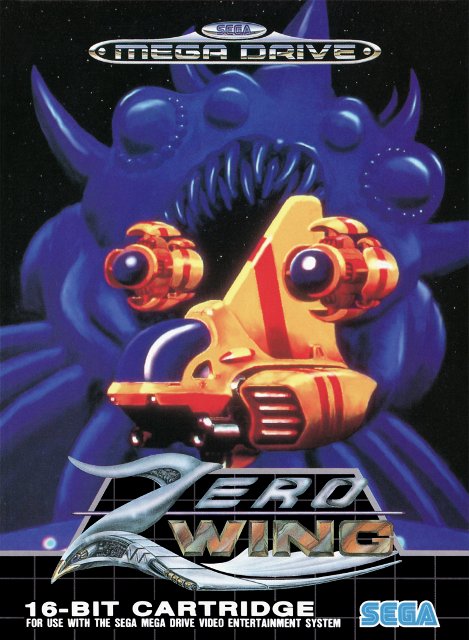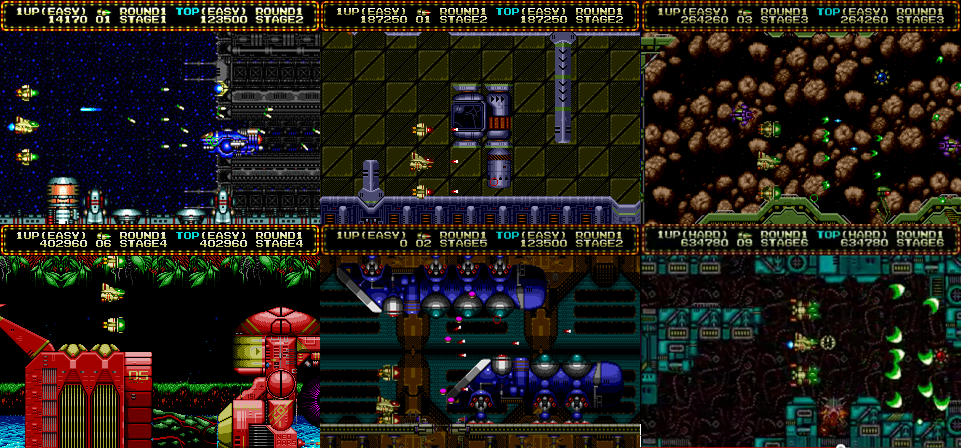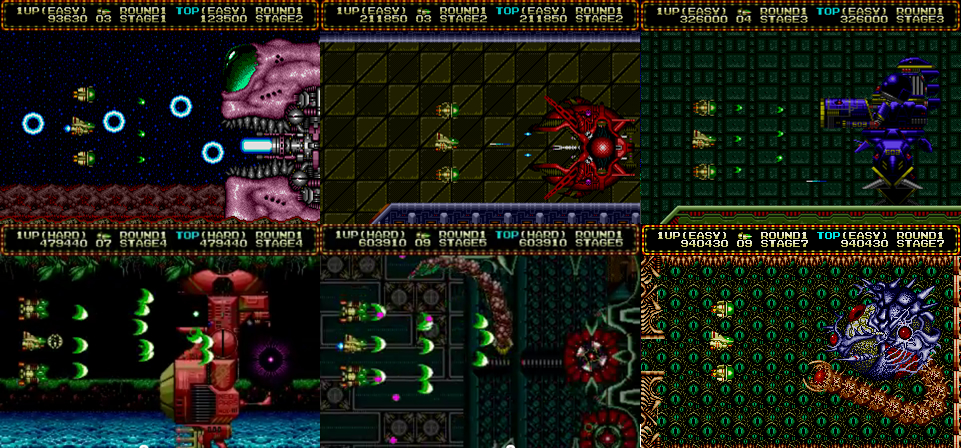Zero Wing is a Mega Drive shooter from Toaplan in 1991 that suffers from two misconceptions endemic to the retro gaming community. They aren’t untruths but rather conceptions blown out of proportion. An actor’s career may be marred by something too candid he says in an interview, a serious musician dismissed for that one too popular song, and yet neither fault was imagined; yet again it would be our fault for ignoring the films and songs that remained.
More Than Just a Meme
 I first learned of Zero Wing very recently; less than a week before writing this article. I’d been a Genesis player many years ago in succession to the NES and before moving on to Playstation, then Saturn, then other things altogether. The one constant whether gaming or not was my avoidance of shooters—a tiny, high-strung experience wholly at odds with my cold blooded inclinations and low gaming skill. Then, a couple of years ago, I returned to gaming, working my way backwards (upwards) from the Xbox and Dreamcast to the Saturn, a console that lost to the Playstation partly because it still had one foot in the arcade past. From there it was only one more step backwards to the Genesis. My renewed Genesis interest led me to Sega-16, where I began to reacquaint myself with its library of short, manageable games, and for the first time pull a few titles off its shooter shelves. As it turned out I remembered some: Fire Shark, Truxton, Steel Empire, comfortingly easy titles, titles unlike the Saturn’s shooters that after half an hour’s chain deaths would make me glance at my hands to check whether my thumbs hadn’t been put on upside-down. And amidst all this dipping and delving I kept stumbling into the quotation: “All your base are belong to us.” A joke from some mistranslated RPG.
I first learned of Zero Wing very recently; less than a week before writing this article. I’d been a Genesis player many years ago in succession to the NES and before moving on to Playstation, then Saturn, then other things altogether. The one constant whether gaming or not was my avoidance of shooters—a tiny, high-strung experience wholly at odds with my cold blooded inclinations and low gaming skill. Then, a couple of years ago, I returned to gaming, working my way backwards (upwards) from the Xbox and Dreamcast to the Saturn, a console that lost to the Playstation partly because it still had one foot in the arcade past. From there it was only one more step backwards to the Genesis. My renewed Genesis interest led me to Sega-16, where I began to reacquaint myself with its library of short, manageable games, and for the first time pull a few titles off its shooter shelves. As it turned out I remembered some: Fire Shark, Truxton, Steel Empire, comfortingly easy titles, titles unlike the Saturn’s shooters that after half an hour’s chain deaths would make me glance at my hands to check whether my thumbs hadn’t been put on upside-down. And amidst all this dipping and delving I kept stumbling into the quotation: “All your base are belong to us.” A joke from some mistranslated RPG.
My precise discovery of Zero Wing’s shooter nature came when pursuing articles by one of the site’s best reviewers. I saw the review commented on in the forums, where I discovered its author, so I looked it up. By then I expected it to be sort of a cross genre, a space sim, you know, something where dialogue’s important. Not at all. And that’s precisely how much Zero Wing’s infamous asyntactic English matters. Forget it. Play the best shooter on the Mega Drive. Incidentally Zero Wing is not a Genesis game; it was an arcade port—an arcade port back when Japanese games were presented in their native language to their native players: the Japanese version contains no English in the cut scenes; that’s only the European version; Toaplan never gave itself the opportunity to correct the translation for the US. Not that the story was going to be great in any translation. Guess what, humanity has created something evil and now is being overrun by an alien force. The defense are surrounded and the Zero Wing is their only hope… Clicking through those cut scenes I thought to myself “Enough of this crap, let’s go save humanity. Actually, humanity sucks. I just want to shoot some stuff.”
If you too are unfamiliar with Zero Wing’s reputation you might be thinking I chose to immerse myself in this game because it like those others is easy. In fact, it’s considered very difficult. But playing safe is dull, and besides I’d already been murdered by Gun Frontier, Metal Black, and Hellfire, so what could it matter? Yet this is the other misconception you should forget. Sure, there’s the old checkpoint + power-up-loss formula, but that formula’s only as brutal as the basic gameplay, which really isn’t too harsh. Occasionally a checkpoint will even advance the Zig (our ship’s unflattering name. I suppose intended to suggest a pet form of Zero Wing). What else contributes to difficulty? Unfair design, slowdown, flicker, off controls…Zero Wing is absolutely free of them. Average as I found it on normal difficulty hardcore gamers may rejoice that it requires two loops to see the optimal ending—yes, that’s three plays through with mounting difficulty each loop. On the new loop your power and speed are reset.
Click to view the stages!
Despite its slow commencement pace I was exhilarated just as I am in much faster horis such as Sol Deace and Border Down. Firstly due to the graphics: great first generation graphics with bold design, lots of sheen, and high contrast. The Zig tilts according as it moves up or down, and its orbs rotate. The backgrounds are simply panels alternated a few times a stage, creating some kinephantom as your ship moves. Stage platforms however are more detailed, and both elements interact well not only with each other but, of maximum importance, with the enemies and bullets, meaning there are absolutely no visibility problems in this game. Popcorn enemies consist of creatures too, not merely ships. Mid and final bosses are huge and colourful; they’re also immobile after a fashion that Abadox fans will find endearing. Thankfully Zero Wing’s levels are athematic: you won’t fly through worlds made up of the four elements or penetrate the onion layers of a death star. Each stage has its own atmosphere without feeling part of a program. The music is rock of various styles and uniformly high quality. (Remember when video game soundtracks never had vocals? Those were the
days. But Darius may be forgiven).
Zig’s arsenal is entirely typical. Default red shot that becomes spread, blue lasers, green homing. As usual homing’s best, but at least the setup’s fair, with red and blue being serviceable, whilst green only hits about 83% of targets (the Zig and each orb has its own stream. Half the time these all hit, half only two do: 100 + 67/2 =83.5). There are also speedups, and just as in every other game that features them maximum speed must be accustomed to for both survival and points. Don’t worry, it’s more controlled than max speed in Truxton, Fire Shark, or Eliminate Down (albeit that uses a different system). Typical? But you’ve heard of a tractor beam. Unfortunately the tractor beam’s a tad lame. I kept forgetting it throughout my first two plays. It captures an enemy for use as a shield (the gnats later on are a humorous choice for this), which can be discharged at one’s pleasure before it takes its lone hit. However there’s another, superior shield which can take 2 hits before on the third exploding as a gravity bomb. It resembles a hoptree samara. You’re right, that doesn’t sound like a very impressive bomb. Indeed it makes a noise like trodden Styrofoam and inflicts only moderate damage. The Zig’s true shields are her orbs; they also serve for running over nearby foes.
Click to see the bosses!
So how did a novice shooter manage to beat a game eight levels long on his fourth try? Right off the bat I lucked on a few rarities. 1UPs are fairly common; you might grab three on a 1LC. There are also 2UPs, and even more prodigal, the 10UP, said to be extremely rare, that I got on my second play of the game and pretty much assured I’d be ready for a serious go at it my next run. Then there’s the fourth power-up; a large purple thing like some alien’s papoose, it raises the Zig’s orbs to their fourth/max power state and shape changes them to resemble pulsing scuba tanks. They inflict 25% more damage and the fattened shot helps one hit just about everything on the screen at once (except of course with the lasers), and better yet the orbs’ elongation means more bullet absorption.
Worth Zeroing In On
Yet Zero Wing’s not a game that requires luck to beat. It’s absolutely smooth, polished, and fair. Most of the reputed Genny/MD masterpieces are sprinkled with glitches of some kind; some are masterpieces still, but their flaws necessitate the player catch a few breaks to beat them. Not so Zero Wing. Perhaps that’s because Toaplan got all its glitches out of the way in the prologue. And if you do struggle at it, so what, it’s worth putting up with a few bad sessions. It’s simply a perfect harmony of visuals and music, reflexes and memory, challenge and pleasure. The only real knock against it is that its cover art’s pretty lame. On the other hand, if you find yourself completely unable to advance, mired in down-powered checkpoints and frustrating deaths, cursing at the review that inspired you to play this impossible game, you can always sit through the Sega screen and console yourself with a hollow laugh at the introduction.



Recent Comments